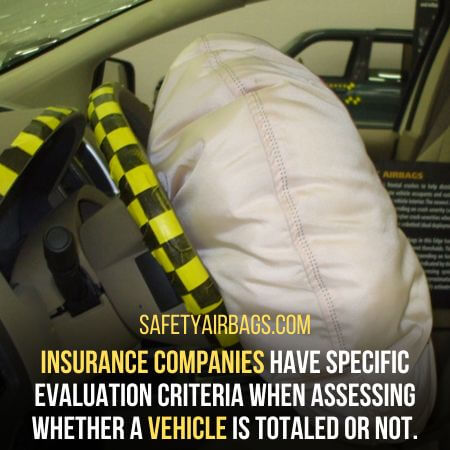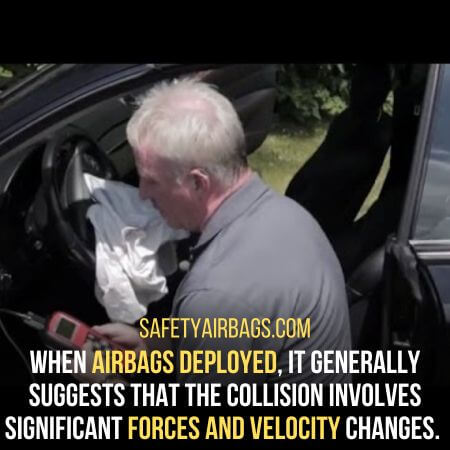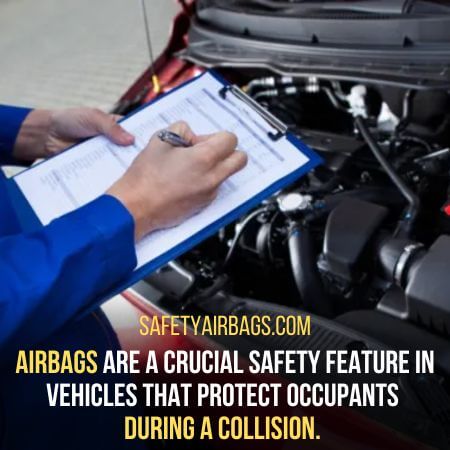Is the car totaled if airbags deploy? The deployment of airbags does not automatically determine whether a car is totaled.
What Will I learn
The decision is based on factors such as the extent of damage, repair costs, and the value of the vehicle, which insurance companies and professionals assess.
Is A car totaled if airbags deploy? General Overview
Deploying airbags alone does not necessarily determine whether a car is considered “totaled” or not.
The term “totaled” typically refers to the condition of a vehicle where the cost of repairs exceeds a certain percentage (usually around 70-75%) of the vehicle’s actual cash value (ACV) or market value.
When airbags deploy, it usually indicates that the car has been involved in a significant collision or accident.
The extent of the damage and the overall condition of the vehicle are factors that determine whether it is considered totaled or repairable.
If the cost of repairing the damage exceeds the threshold set by the insurance company, they may declare the car as totaled.
Determining Vehicle Totalling
Determining vehicle totals involves evaluating factors such as the insurance company’s criteria, extent of damage, structural integrity, repair costs, and the vehicle’s value.
These considerations help determine whether the vehicle should be declared a total loss or repaired.
1. Insurance Perspective on Total Loss:
Insurance companies typically have specific evaluation criteria when assessing whether a vehicle is totaled.

These criteria may include the vehicle’s age, pre-accident condition, mileage, and market value.
Insurance adjusters use these criteria to determine the feasibility of repairing the vehicle versus declaring it a total loss.
Various factors influence the insurance company’s decision regarding whether a vehicle is a total loss.
These factors can include state laws and regulations, insurance policy terms, the extent of damage, repair costs, and the vehicle’s value.
Insurance companies aim to make an informed decision that balances the cost of repairs with the vehicle’s value.
2. Assessing the Extent of Damage:
External and internal damage is considered when determining if a vehicle is totaled.
External damage includes visible signs such as crumpled body panels, broken lights, or a damaged frame.
Internal damage refers to issues that may not be immediately visible, such as damage to the engine, transmission, or other critical components.
Assessing the vehicle’s structural integrity is crucial in determining whether it can be repaired or is a total loss.
Structural damage may compromise the safety and performance of the vehicle, making it uneconomical or unsafe to repair.
Factors considered in evaluating structural integrity include the extent of frame damage, alignment issues, and the integrity of the vehicle’s structural components.
3. Repair Costs versus Vehicle Value:
The cost of repairs plays a significant role in determining if a vehicle is totaled.
Insurance companies compare the estimated repair costs with the vehicle’s actual cash value (ACV).
If the cost of repairs exceeds a certain percentage (typically 70-75%) of the ACV, it may be more cost-effective to declare the vehicle a total loss.
The specific threshold for declaring a totaled car varies by the insurance company and jurisdiction.
Generally, the insurance company will declare the vehicle a total loss if the repair costs exceed the predetermined threshold.
The threshold is based on a combination of factors, including the vehicle’s value, repair costs, salvage value, and local regulations.
Airbag Deployment and Car Damage
Airbag deployment is indicative of high-impact collisions, with sensors detecting collision severity.
Airbags protect occupants by cushioning the impact and reducing the risk of severe injuries during a crash.
The Relationship between Airbag Deployment and Severity of the Accident:
Airbag deployment is often associated with high-impact collisions.
When airbags are deployed, it generally suggests that the collision involves significant forces and velocity changes.

The rapid inflation of airbags is triggered by sensors that detect the severity of the impact, indicating a substantial collision event.
Various collision dynamics influence the deployment of airbags.
Factors such as the direction of impact, the speed of the vehicles involved, and the collision angle play a role in determining the timing and intensity of airbag deployment.
Airbag deployment systems are designed to activate in specific collision scenarios to provide optimal protection to the occupants.
Airbags as a Safety Feature:
Airbags protect vehicle occupants during crashes by reducing the risk of severe injuries.
When a collision occurs, the rapid inflation of the airbags creates a cushioning effect that absorbs and disperses the forces generated by the impact.
This helps to minimize the potential for head, chest, and other impact-related injuries.
Airbag deployment is made possible by sophisticated sensor systems within the vehicle.
These sensors detect deceleration, impact direction, and seat occupancy.
In the event of a collision, the sensors send signals to the airbag control unit, which triggers the inflation process based on the data received.
The sensors play a vital role in ensuring airbags deploy accurately and promptly.
Airbags are a critical safety feature that can significantly reduce the risk of severe injuries to vehicle occupants during a collision.
The relationship between airbag deployment and the accident’s severity is closely linked, with airbags serving as indicators of high-impact collisions.
The dynamics of the collision, including the direction and speed, influence the deployment process.
Airbag sensors are crucial in detecting collisions and activating the airbags to protect the occupants.
Overall, airbags are designed to provide a vital layer of safety during crashes, mitigating potential damage and reducing the severity of injuries.
Regional Regulations and Variations
When it comes to determining whether a car is considered “totaled,” there can be variations and differences based on regional regulations and insurance practices.
Different regions or states may have their own specific guidelines and thresholds for assessing a vehicle’s condition after an accident.
For example, some regions may have higher or lower percentage thresholds for the cost of repairs compared to the vehicle’s actual cash value.
This means that in one area, a car might be deemed totaled if the repair costs exceed 70% of the vehicle’s ACV, while in another area, the threshold might be set at 75% or even higher.
Regional Regulations Influencing Decision-Making:
Regional regulations play a significant role in influencing the decision-making process regarding whether a car is considered totaled.
These regulations may be established by government agencies or insurance regulatory bodies.

They ensure consistency and fairness in determining the status of a vehicle after an accident.
These regulations might outline specific criteria for assessing the extent of damage, repair costs, and market value calculations.
They may also provide guidance on salvage titles, insurance payouts, and the legal obligations of insurance companies in these situations.
Differences between Insurance Companies:
Insurance companies may have different thresholds for the cost of repairs compared to the vehicle’s actual cash value.
This can result in different outcomes for the same accident. Some insurers might be more willing to repair a vehicle with higher repair costs.
Others may prefer to declare it totaled due to potential safety concerns or other factors.
Furthermore, insurance companies may have different approaches to calculating market value or assessing additional damages beyond airbag deployment.
They may also vary in the options offered to the policyholder, such as salvage buyback programs or the choice to retain a totaled vehicle.
Understanding Airbags
Airbags are vital safety features in vehicles that protect occupants during collisions.
They rapidly inflate and deflate upon impact, reducing the risk of severe injuries to the head, chest, and other body parts.
Different types of airbags, such as frontal, side, curtain, knee, and seat-mounted airbags, serve specific purposes.
Airbag deployment relies on sensors and control units to detect collisions and trigger inflation.
Purpose and Function of Airbags:
Airbags are a crucial safety feature in vehicles that protect occupants during a collision.
They aim to mitigate the impact force on individuals by rapidly inflating and deflating upon contact.

When a collision occurs, airbags act as a cushioning barrier between the occupant and hard surfaces within the vehicle.
They reduce the risk of severe injuries to the head, chest, and other body parts.
Different Types of Airbags:
Various types of airbags are installed in vehicles, each serving a specific purpose.
The most common types include frontal airbags, side airbags, curtain airbags, knee airbags, and seat-mounted airbags.
Frontal airbags are typically located in the steering wheel and dashboard, while side airbags are integrated into the sides of the seat or door panels.
Curtain airbags deploy from the roof area to protect occupants’ heads in the event of a side impact.
Knee airbags protect the lower extremities, and seat-mounted airbags are located within the seats to safeguard the occupants’ torso.
Airbag Deployment Mechanisms:
Airbag deployment relies on sophisticated sensors and control units that detect collision forces and trigger the inflation process.
These sensors measure parameters, such as deceleration, impact direction, and seat occupancy, to determine airbag deployment’s appropriate timing and intensity.
Once the sensors detect a collision exceeding a certain threshold, the control unit triggers the ignition of a solid fuel, rapidly inflating the airbag.
The inflated airbag then deflates gradually, absorbing the energy of the occupant’s forward motion and minimizing potential injuries.
Conclusion:
Determining whether a vehicle should be declared a total loss or repaired involves considering factors.
These include the cost of airbag replacement, associated repair expenses, safety concerns, diminished value, and insurance policies.
The decision aims to balance economic feasibility and ensure the vehicle’s safety and roadworthiness.
By carefully assessing these factors, individuals and insurance companies can make well-informed decisions that prioritize safety and consider the vehicle’s long-term value.
